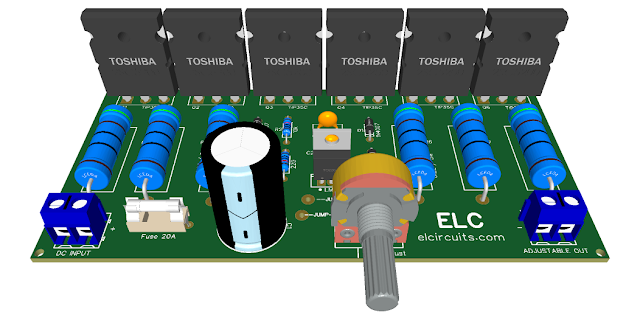 | |
|
You may be interested in:
- Switched Power Supply SMPS 13.8V 10A using IR2153 IC and IRF840, with PCB
- Adjustable Power Supply 1.5V to 28V, 7.5 Amps With IC LT1083 + PCB
- Adjustable Power Supply 1.2V to 37V, 6A, Short Circuit Protection with LM317 and TIP36 + PCB
- Adjustable Switching Power Supply 5.1 to 40V, 2.5 Amp using L4960 + PCB
- Symmetrical Adjustable Power Supply 1.25V to 47V 10 Amps with Short Circuit Protection + PCB
- Adjustable Power Supply 1.25v to 57V, 6 Amps with TIP36C + LM317HV + PCB
- Adjustable Power Supply 1.25v to 33V, 3 Amps with LM350 + PCB
- Stabilized Power Supply 13.8V High Current 10 Amps with PCB
Circuit Operation
 | |
|
Components List
- U1 ............................ LM317 voltage regulator integrated circuit
- Q1 to Q6 .................. TIP35C Power Transistor
- D1, D2, D3, D4 ....... 1N4007 Silicon rectifier diodes
- C1 ............................ 4700uF - 63V Electrolytic capacitor
- C2, C3 ..................... 0.1uF Ceramic / Polyester Capacitor
- R1 ............................ 220 ohms 1 / 4W Resistor - (red, red, brown, gold)
- R2 ............................ 10K ohms - 1/4 W Resistor - (brown, black, orange, gold)
- R3 to R8 .................. 0.22 ohms - 5W Resistor - (red, red, silver, gold)
- P1 ............................ 5k ohms Potentiometer
- J1, J2 ....................... PCB Terminal Blocks - EK500V-XXP 20A - or equivalent
- F1 ............................ PCB Fuse Clip Cartridge 250V 30A With Fuse 20A
- Others ..................... Wires, Welds, Posts, PCB, Etc.
For those who want to download materials such as the schematic diagram in PDF, PCB Layout, GERBER and JPG, we are providing a direct link to download all the material.
Direct link to download
Click in the link to download the Files: PCB Layout, PDF, GERBER, JPG
If you have any questions, suggestions or corrections, please leave them in the comments and we will answer them soon.
Subscribe to our blog!!! Click here - elcircuits.com!!!
My Best Regards!!!

















